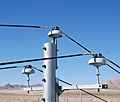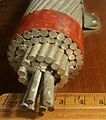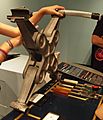Power line facts for kids
Power lines are like super-highways for electricity! They are special wires that carry electric power from where it's made (like a power plant) to homes, schools, and businesses. Imagine them as giant cables that help light up our world and power our devices.
Contents
What Are Power Lines?
Power lines are wires that conduct electricity from one place to another. They are usually made of strong metals like aluminum. These wires are designed to carry electricity safely over long distances. You often see them held up high on tall poles or towers. Some power lines are also buried underground.
How Electricity Travels Through Power Lines
Electricity begins its journey at a power plant. Here, giant machines called generators create the electric power. This power then needs to travel to many different places.
The Role of Transformers
As electricity leaves the power plant, its voltage (which is like the "pressure" of electricity) is very high. This high voltage helps the electricity travel long distances without losing too much energy.
- Stepping Up: Sometimes, the electricity needs an extra boost to go even further. It passes through a special device called a "step-up transformer". This transformer increases the voltage even more. This process is called "stepping up".
- Stepping Down: When the electricity gets close to buildings, its voltage is still too high to be used safely. It then goes through another type of transformer, a "step-down transformer". This transformer lowers the voltage to a safe level for homes and businesses. This process is called "stepping down".
After being "stepped down," the electricity is ready to be used. The voltage you use in your home is usually 100V (in Japan), 120V (in North and Central America), or 220-240V (in most other parts of the world).
Related pages
Images for kids
-
A man working on powerlines in Nauru (2007)
-
Low-profile power lines near an airfield
-
Aerial bundled cable in Old Coulsdon, Surrey
-
The Ekibastuz–Kokshetau high-voltage line in Kazakhstan. It was the first commercially used power line which operated at 1150 kV, the highest transmission line voltage in the world.
See also
 In Spanish: Línea eléctrica aérea para niños
In Spanish: Línea eléctrica aérea para niños



















